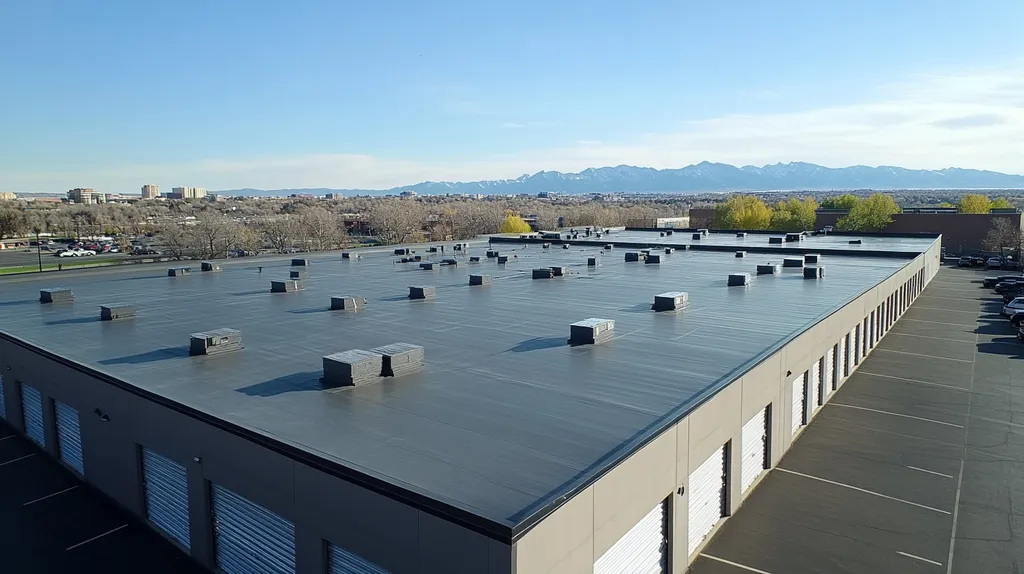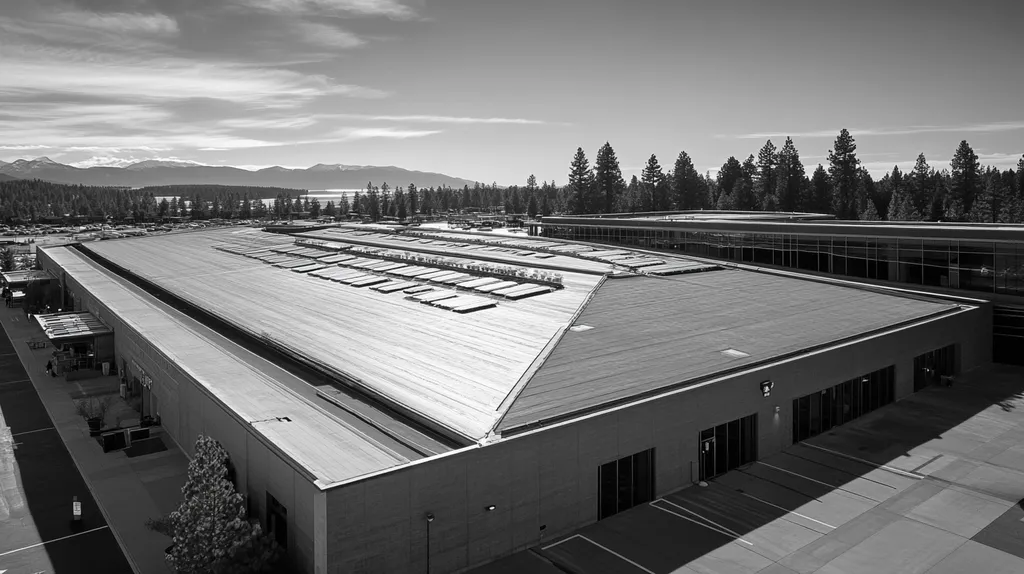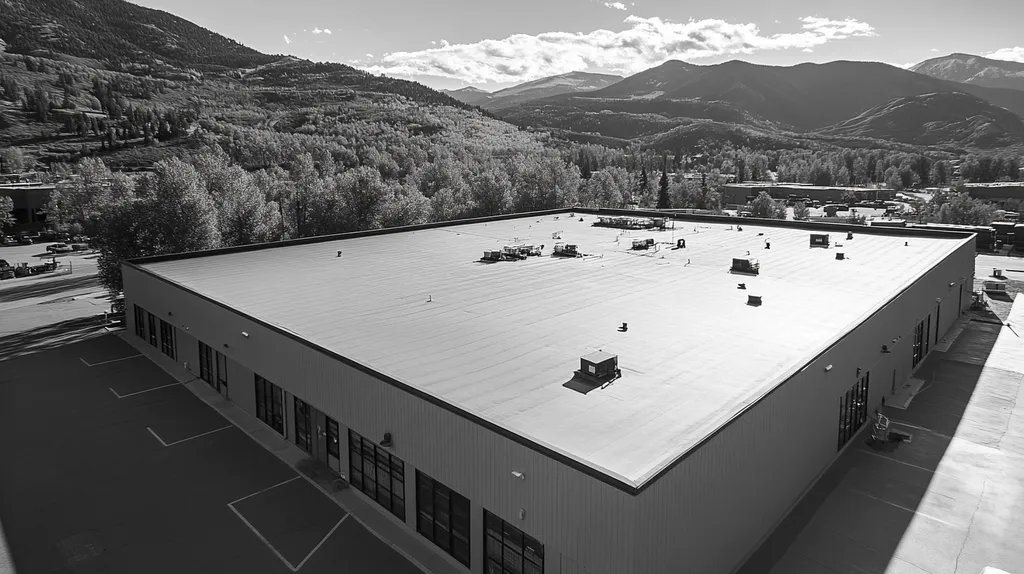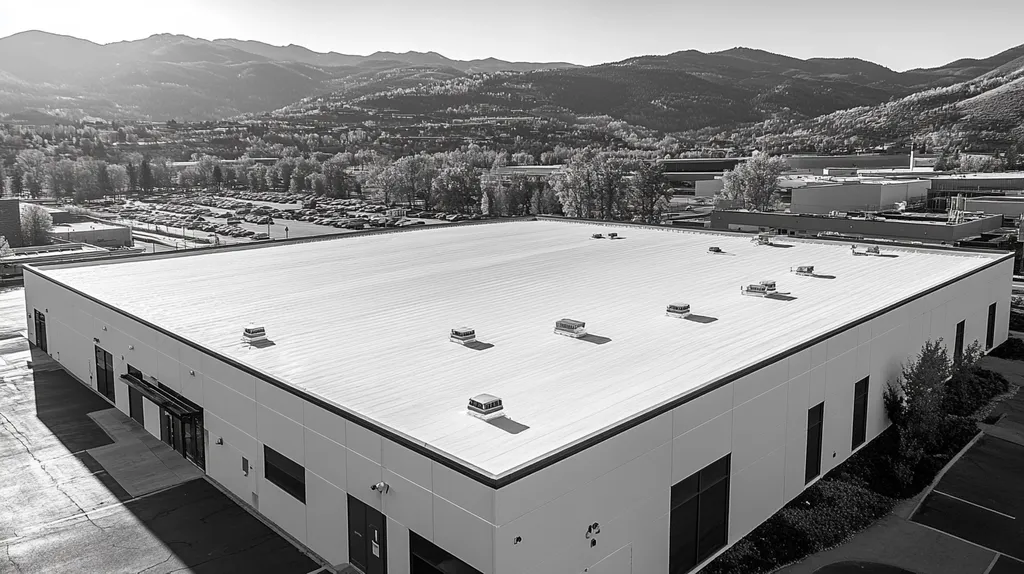With industrial energy costs rising 12% annually, facility managers can no longer afford inefficient roofing systems that hemorrhage heating and cooling dollars. Studies show that optimized industrial roofs can reduce total facility energy consumption by up to 30%.
Yet many organizations continue operating with outdated roofing configurations, missing opportunities for dramatic cost reduction through smart material choices, proper maintenance, and strategic upgrades.
This comprehensive guide examines the key factors driving industrial roof energy performance, from initial design to long-term operation, providing facility managers with actionable solutions to maximize efficiency and minimize expenses.
SECTION 1: PERFORMANCE FACTORS
With energy costs rising, the efficiency of industrial roofs is more important than ever. Choosing the right roofing materials, ensuring proper insulation, and applying reflective surfaces can make a significant difference in energy consumption. According to the U.S. Department of Energy, effectively managed roofs can account for as much as 25% of a facility’s total energy use. Facility managers must understand and optimize these performance factors to lower overhead costs effectively.
Roof Material Selection
Choosing the right roofing material is a critical factor in energy consumption. Traditional roofing materials, like asphalt shingles, often lack the insulation needed for effective temperature control. In contrast, advanced options such as metal or thermoplastic olefin not only provide improved reflectivity but also promise greater durability.
Facilities equipped with insulated metal roofs can experience remarkable energy savings by decreasing the demands on heating and cooling systems. Furthermore, eco-friendly choices like green roofs not only enhance insulation but also support sustainability goals.
Selecting higher-performing materials goes beyond aesthetics; it has a direct impact on energy efficiency. Materials with elevated R-value ratings ensure better thermal performance, leading to significant cost savings over time. Therefore, facility managers must prioritize material selection in their energy optimization strategies.
Key Action Items
Insulation and Ventilation
Effective insulation and ventilation are essential for energy-efficient industrial roofs. Quality insulation minimizes heat transfer, maintaining consistent indoor temperatures, while inadequate insulation can lead to soaring heating or cooling costs.
Ventilation systems complement insulation by regulating roof temperature, especially during warm months. Proper ventilation reduces heat buildup in warehouses or factories, preventing HVAC systems from overworking and leading to lower energy expenses.
For instance, adding a vapor barrier can significantly enhance insulation effectiveness and minimize moisture accumulation. A well-planned insulation and ventilation strategy improves energy performance and can extend the lifespan of the roof, ensuring sustained efficiency.
Key Action Items
Reflective Coatings and Surfaces
Utilizing reflective coatings and surfaces is vital for minimizing heat absorption in industrial roofs. These coatings reflect sunlight, significantly reducing roof temperatures and lowering cooling loads during hot months. Facilities lacking such coatings may incur unnecessary energy expenses.
Research indicates that reflective coatings can decrease roof surface temperatures by up to 30 degrees Fahrenheit. This reduction translates into substantial energy savings, making it a critical consideration for facility managers.
Applying reflective materials or coatings not only boosts energy efficiency but also extends the roof’s lifespan by minimizing thermal stress. For industrial properties, this approach can lead to lower maintenance costs and a decreased likelihood of needing premature roof replacements.
Key Action Items
SECTION 2: FINANCIAL CONSIDERATIONS
For industrial facility managers, investing in energy-efficient roofing solutions is a crucial priority. Poorly performing roofs can significantly inflate energy costs, with heating and cooling accounting for nearly 30% of total energy consumption in commercial buildings. Understanding these financial implications is essential for making informed decisions that benefit both the environment and the organization’s budget.
Initial Investment and Cost-Benefit Analysis
Investing in energy-efficient industrial roofing may feel daunting due to the potential for significant costs, potentially reaching thousands of dollars. However, facility managers should perform a comprehensive cost-benefit analysis to uncover the long-term advantages. Options like reflective surfaces or upgraded insulation can lead to substantial savings over time.
A straightforward calculation comparing energy savings against initial installation costs clarifies profitability. For example, something as simple as a reflective roof can reduce cooling expenses by up to 20% during hot summer months, effectively compensating for the initial outlay over the lifespan of the roof.
Additionally, looking into local financing options, tax credits, or rebates for energy-efficient upgrades can alleviate financial pressures. A thorough analysis should encompass not just upfront costs but also the reaped long-term financial benefits, forging a strong case for energy-efficient investments.
Key Action Items
Long-Term Energy Savings and ROI
Long-term energy savings significantly influence roofing decisions. Energy-efficient roofs often lead to lower energy bills directly impacting ROI. Research indicates that well-insulated and reflective roofs can cut annual energy costs by up to 30%, resulting in considerable returns over time.
Calculating ROI involves recognizing both direct and indirect savings. Decreased strain on HVAC systems means reduced repairs and maintenance, while enhanced workplace conditions can boost productivity—all contributing to the facility’s financial health.
Utilizing simulation tools to project energy savings over the roof’s lifespan can guide planning. For instance, if a roof is expected to last 20 years, managers can estimate savings and energy price inflation, painting a promising financial future.
Incorporating these insights, energy-efficient roofs provide immediate benefits while establishing a sustainable financial model that prioritizes efficiency as a long-term asset.
Key Action Items
Maintenance and Repair Costs
Maintenance and repair expenses are crucial when assessing the overall financial impact of an industrial roof. High-quality energy-efficient roofs typically require less frequent repairs, translating into lower long-term costs. Routine inspections can identify issues early, preventing costly emergency repairs down the road.
Conversely, traditional roofs can degrade more quickly, leading to escalated maintenance costs. By investing in robust energy-efficient materials, the lifespan of the roof increases, thereby minimizing repair frequency and related expenditures.
Additionally, many roofing systems come with warranties that can cover various repairs, acting as a financial safety net. Understanding these warranties can significantly enhance the financial rationale behind energy-efficient roofing choices.
Ultimately, incorporating ongoing maintenance analysis offers a comprehensive view of the financial implications, reinforcing the notion that intelligent roofing decisions can enhance energy efficiency and help prevent costly repairs.
Key Action Items
SECTION 3: COMPLIANCE REQUIREMENTS
Overlooking compliance requirements can jeopardize both energy efficiency efforts and operational budgets for industrial roofs. Facilities not adhering to energy codes may face expensive fines and increased utility costs. Thus, facility managers must be well-versed in regulations surrounding roofing performance, energy efficiency, and environmental compliance to safeguard their investments and foster sustainability. This section breaks down critical compliance categories and emphasizes their role in energy consumption.
Building Codes and Regulations
Building codes set the standards for the structural integrity, safety, and energy efficiency of industrial roofs. These codes are continually updated to reflect advancements in technology and changes in climate. Ignoring local, state, or national codes can result in costly retrofits or violations that burden facility budgets.
For example, the International Building Code (IBC) outlines standards that directly influence roofing materials and designs. Facility managers must ensure roofs are built to withstand local weather conditions, ultimately minimizing maintenance and repair costs over time.
Additionally, certain regions have specific codes that target energy performance. By understanding these requirements, facility managers can align their roofing projects with energy-saving objectives while steering clear of potentially hefty penalties.
Key Action Items
Energy Efficiency Standards
Energy efficiency standards, such as those established by the American Society of Heating, Refrigerating and Air-Conditioning Engineers (ASHRAE), play a vital role in setting benchmarks for energy performance. Achieving or surpassing these standards can significantly lower energy consumption and reduce operational expenses.
For instance, implementing systems like cool roofs can decrease surface temperatures, thereby lessening the demand on HVAC systems. This adjustment not only enhances indoor comfort but also aligns with energy efficiency goals, facilitating more effective operational assessments.
Moreover, numerous states and local governments provide incentives for adopting energy-efficient upgrades. Facility managers should proactively pursue these incentives, as they can help mitigate initial costs incurred from implementing compliant roofing systems.
Key Action Items
Environmental Compliance
Environmental compliance focuses on regulations regarding emissions, waste disposal, and the sourcing of materials. In light of increasing environmental regulations, noncompliance can result in severe legal and financial ramifications.
For instance, the Environmental Protection Agency (EPA) enforces regulations concerning roofing materials that may contain harmful substances. Opting for compliant materials not only minimizes legal risks but also aligns with broader sustainability initiatives.
Additionally, organizations that prioritize environmental responsibility often enhance their corporate image, attracting clients and investors focused on eco-friendliness. This strong reputation can provide a competitive edge in the marketplace.
To effectively manage compliance, facility managers should engage with environmental consultants who can guide them through complex regulations. A focus on improving a facility’s environmental footprint can foster innovation and lead to long-term cost savings.
Key Action Items
SECTION 4: RISK MANAGEMENT
In the fast-paced world of industrial management, proactively addressing roofing risks has become a top priority. With increasing energy costs and regulatory scrutiny, it’s essential for facility managers to incorporate strategies that mitigate risks. The U.S. Environmental Protection Agency reports that heat islands can elevate local temperatures by 1-7°F, further driving up energy expenses. This section highlights the importance of heat island effect mitigation, stormwater management, and maintaining structural integrity.
Heat Island Effect Mitigation
The heat island effect poses a considerable challenge for energy consumption in industrial facilities. Traditional roofing materials often absorb and retain heat, raising ambient temperatures and increasing air conditioning demands—resulting in higher energy bills.
To combat this, reflective roofing materials, often referred to as cool roofs, play a pivotal role. Cool roofs can reflect sunlight and absorb far less heat, lowering surface temperatures by as much as 30%, which can substantially cut overall energy expenses.
Additionally, installing green roofs filled with vegetation can enhance insulation while also aiding in air quality. Plants not only provide shade but also absorb sunlight, further reducing heating needs and promoting sustainability.
Key Action Items
Stormwater Management
Stormwater management is essential for compliance and operational efficiency. Inadequately controlled stormwater runoff can lead to flooding, jeopardizing both safety and facility operations, especially in areas prone to heavy rainfall.
Implementing an effective stormwater management plan can greatly minimize runoff and the risk of water damage. Facilities should consider employing permeable materials, like permeable pavers or green roofs, which can absorb rainwater naturally.
Moreover, integrating stormwater catchment systems allows facilities to utilize collected rainwater for irrigation or cooling processes, markedly reducing overall water consumption.
Key Action Items
Structural Integrity and Durability
Ensuring a roof’s structural integrity is crucial; a compromised roof can result in severe failures. Roof systems must be adept at handling local weather conditions to avoid costly damage and inefficiencies.
High-quality, durable materials can significantly contribute to both the longevity and insulation of a roof, thus affecting energy consumption positively. For example, reinforced membranes can withstand harsh conditions while minimizing leaks and energy losses.
To maintain structural soundness, routine inspections and maintenance are vital. By identifying issues before they escalate into major repairs, facilities can avoid increased downtime and operational costs.
Key Action Items
SECTION 5: OPERATIONAL PROCEDURES
Implementing effective operational procedures is vital for enhancing energy efficiency in industrial roofing systems. Neglecting regular maintenance can lead to elevated energy costs and deteriorating roof conditions. Research indicates that well-maintained roofs have the potential to lower energy consumption by as much as 30%. Facility managers must prioritize consistent inspections, timely repairs, and robust training for personnel to ensure optimal roof performance and sustainability. This section details essential practices to enhance overall roof efficiency.
Regular Maintenance and Inspections
Regular maintenance and inspections are foundational to achieving energy efficiency. Facility managers should schedule inspections at least bi-annually to catch potential issues early. For example, identifying and sealing minor leaks can prevent significant energy losses down the road.
Common maintenance tasks include cleaning gutters, removing debris, and assessing roof wear. A clean roof surface enhances insulation and reflectivity, improving overall building energy performance. Addressing any standing water promptly is essential, as it can lead to costly repairs and energy inefficiency.
Maintaining a detailed log of repairs and services helps track historical performance, revealing patterns that may demand attention. This data analysis can lead to targeted interventions focused on optimizing roof functionality and efficiency.
Key Action Items
Repair and Replacement Strategies
Developing effective repair and replacement strategies is key to sustaining roof energy efficiency. When roofing materials begin to show wear, timely repairs can prevent further damage and energy losses. For example, addressing damaged insulation promptly can lead to reduced heating and cooling costs.
Facility managers must evaluate the roof’s overall condition before deciding between repairs and complete replacements. If repairs become too frequent or costly, investing in a new, energy-efficient roofing system may be more economical.
Moreover, selecting high-performance materials like reflective coatings or energy-efficient membranes enhances savings and extends roof lifespan. Conducting regular energy audits helps pinpoint specific areas for improvement, guiding decision-making for both immediate actions and future upgrades.
Key Action Items
Training for Facility Personnel
Regular training for facility personnel is essential for maintaining energy-efficient roofing practices. Staff should understand how roof maintenance impacts energy consumption, fostering a proactive approach to efficiency initiatives.
Training sessions should focus on identifying roof damage, understanding insulation properties, and the importance of keeping roofs clean. Regular workshops reinforce these concepts, aligning team goals with the facility’s overarching energy objectives.
Utilizing roof management software during training can streamline inspections and monitoring. Personnel proficient in these systems can assess roof conditions accurately and report issues effectively, enhancing operational efficiency.
Key Action Items
SECTION 5: OPERATIONAL PROCEDURES
Establishing effective operational procedures is essential for maximizing energy efficiency in industrial roofing systems. Failing to perform regular maintenance can lead to rising energy costs and accelerate roof wear and tear. Research shows that a well-maintained roof can cut energy consumption by as much as 30%. Facility managers must emphasize ongoing inspections, timely repairs, and thorough training for personnel to maintain peak roof performance and sustainability. This section breaks down critical practices necessary for enhancing roof efficiency.
Regular Maintenance and Inspections
Consistent maintenance and inspections are the backbone of energy efficiency. Facility managers should plan for inspections at least twice a year to catch potential issues before they escalate. Identifying and sealing minor leaks, for instance, can prevent significant energy losses in the long run.
Key maintenance tasks should involve clearing gutters, removing debris, and inspecting for signs of wear. A clean roof surface boosts insulation and reflectivity, which in turn elevates the overall energy performance of the building. It’s crucial to promptly address any standing water, as it can lead to costly repairs and increased energy waste.
Maintaining a detailed log of all repair and maintenance activities is also vital. This documentation helps identify trends and persistent issues, allowing for targeted interventions that improve roof performance. Building a reliable relationship with a roofing contractor can ensure swift responses to problems discovered during inspections.
Key Action Items
Repair and Replacement Strategies
Developing proactive repair and replacement strategies is vital for preserving roof energy efficiency. When roofing materials start showing wear, timely interventions can prevent further damage and energy losses. For example, prompt replacement of damaged insulation can lead to reduced heating and cooling costs.
Facility managers need to carefully evaluate the roof’s condition to decide whether repairs or a complete replacement is necessary. If repairs become too frequent or costly, investing in a new, energy-efficient roofing system may become the more economical option.
Additionally, selecting high-performance materials—like reflective coatings or energy-efficient membranes—can drive energy savings and prolong roof life. Conducting regular energy audits helps identify areas for improvement, guiding decisions for both immediate repairs and future upgrades.
Key Action Items
Training for Facility Personnel
Comprehensive training for facility personnel is crucial to sustaining energy-efficient roofing practices. Staff should be educated on how roof maintenance impacts energy consumption, creating a culture focused on energy efficiency.
Training sessions must cover essential topics, including identifying roof damage, understanding insulation properties, and the importance of keeping roofs clean. Regular workshops can reinforce these key concepts and align team goals with the facility’s energy objectives.
Incorporating technology, such as roof management software, during training can simplify inspections and monitoring. Teams familiar with these systems can accurately assess roof conditions and report issues promptly, promoting operational efficiency.
Key Action Items
The Bottom Line
With energy costs rising 12% annually, industrial facilities can no longer afford inefficient roofing systems that compromise their bottom line and environmental impact. Studies consistently show that optimized industrial roofs can reduce total facility energy consumption by 15-30%.
Through strategic material selection, proper maintenance protocols, and adherence to compliance standards, facility managers can dramatically decrease energy waste while extending roof lifespans. The data is clear – investments in roof optimization deliver measurable returns.
Moving forward, organizations must prioritize their roofing systems as critical infrastructure rather than passive building components. Those that fail to act risk falling behind competitors while shouldering unnecessary operational costs that impact both profitability and sustainability goals.
The time for roofing optimization is now – the technology exists, the ROI is proven, and the stakes continue to rise.
FREQUENTLY ASKED QUESTIONS
Q. How do roofing materials affect energy consumption in industrial roofs?
A. The choice of roofing materials plays a critical role in energy efficiency. Insulated and reflective materials can significantly lower heating and cooling demands. Investing in high R-value products helps maintain consistent indoor temperatures and cuts energy costs over time.
Q. What financial benefits come from upgrading to an energy-efficient commercial roof?
A. Upgrading to energy-efficient roofing helps reduce energy bills significantly, potentially saving as much as 30%. The initial investment is often outweighed by long-term savings through lowered maintenance and operational costs.
Q. What compliance requirements should I consider for my industrial roof?
A. Compliance with building codes, energy efficiency standards, and environmental regulations is essential. Overlooking these can result in fines and higher operational costs. Ensure your roof meets local and national regulations to avoid penalties.
Q. How can I mitigate risks associated with my industrial roof?
A. To mitigate risks, incorporate strategies like using reflective materials to minimize heat retention and implementing robust stormwater management systems. Performing regular inspections allows early detection of potential issues.
Q. Why are operational procedures important for roof energy efficiency?
A. Proper operational procedures like routine maintenance and timely repairs ensure optimal performance of the roof. Ignoring these can lead to increased energy costs and a shorter lifespan for the roofing system.
Q. How can I improve the training of personnel regarding industrial roofs?
A. Regular training sessions focused on maintenance practices and the impact of roof efficiency can strengthen your team’s skills. Incorporating technology and software for tracking roof conditions should also be a part of the training to enhance operational effectiveness.
Q. What are emerging trends in energy-efficient roofing technologies?
A. Emerging trends include the use of green roofs and advanced solar roofing technologies. These innovations not only improve energy efficiency but also support sustainability goals, appealing to environmentally-conscious stakeholders.











